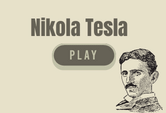Nikola Tesla Facts Game Quiz Online
This page features a Nikola Tesla Facts Game Quiz Online. It is a great exercise for students in 3rd to 9th grades. Tesla was the pioneer inventor of alternating current (A.C.) which revolutionised the grid electric system. There are many more inventions and patents held by him. This interactive fun game will teach you some interesting facts about Tesla. Hit the start button to begin. Remember to share with your class if need be.

Nikola Tesla - The Father of Robotics
Nikola Tesla was a Serbian-American electrical engineer and futurist. He is most notable for his contributions to the modern alternating current electricity supply system. He also worked with radio to create radio control. Learn more about this visionary genius and the many other contributions he made to science and technology. And don't forget to share his discoveries with others.
Nikola Tesla was a visionary thinker
One of the most fascinating aspects of Nikola Tesla was his ability to use his mind to make extraordinary inventions. This incredible inventor never sketched his ideas on paper. Due to his extraordinary brain power, he was able to think about his inventions safely and without fear of losing them or letting someone copy them. The amazing thing about him is that his creations were so revolutionary, they changed the world and will forever be regarded as milestones in history.
Despite being an eccentric figure, Nikola Tesla is credited with advancing the science of electricity. While his inventions became a staple of modern life, his visionary thinking kept him from participating in the practical side of things. Even today, we can see many of his inventions on television. If we look at his contributions in the world today, we can see that they laid a solid foundation for a lot of technologies.
He invented alternating current
Nikola Tesla was an inventor and a successful businessman who is credited with introducing Alternating Current (A.C.). After experimenting with the concept for more than a decade, he eventually created his own Tesla Electric Company, which became wildly successful. But Thomas Edison was wary of the Alternating Current system, which could ultimately replace his Direct Current. As a result, Thomas Edison feared Alternating Current would ultimately take over the world's electrical grid.
Edison, a competitor of Tesla, was not a fan of the AC system and electrocuted animals as part of his marketing campaign. Tesla was not as competitive as Westinghouse and averting the public's gaze was important to his business. But his success paid off in the end, and more companies started using it. General Electric, who had been using direct current for decades, later switched to Alternating Current.
He invented radio control
The idea of radio-controlled boats was first demonstrated by Nikola Tesla in 1898, at the Electrical Exhibition in Madison Square Garden. Tesla's demonstration was a marvel of science and magic - he even managed to make the boat turn on its own. The crowd was so enthralled that they called it telepathy or magic, and even trained a monkey to do the trick. Today, this technology is widely used for everything from drones to remote-controlled boats.
After conducting his experiments at Colorado Springs, Nikola Tesla changed his perspective on radio transmission. With radio control, information could be sent from anywhere in the world and could be used for industrial purposes. While his experiments were thrilling and impressive, they were only part of his grand plan to send radio signals overseas. While the rest of his work centered on a wireless power transmission system, his efforts were hailed by John Pierpont Morgan.
He invented early robotics
It was in 1898 that the Father of Robotics, Nikola Tesla, demonstrated his robot boat to an audience in New York City. Before Isaac Asimov made robots fashionable, Tesla enthralled onlookers with his demonstration. The following year, he built a more advanced model that allowed him to control the boat remotely using radio waves. The first public demonstration of robotics took place at Madison Square Garden.
Although the technology for autonomous robots didn't really exist in his time, his ideas are still incredibly relevant today. Tesla's vision of the future was based on the idea that humans can harness energy from the earth to power their machines. His vision for a future without war is a clear example of that. In 1882, he also predicted the rise of manned spaceflight. His predictions for the future more or less accurately describe the state of technology today.
